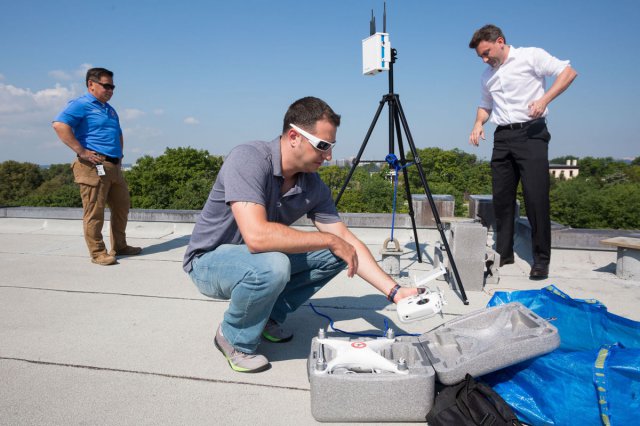A 56-day drone-detection pilot test demonstration has been completed at Joint Base Myer-Henderson Hall, revealing 95 instances of previously undetectable unmanned aircraft systems (UAS) activity in the installation’s immediate vicinity.
Through a pilot effort between JBM-HH and Dedrone, a German-American company specializing in counter-drone technology, a drone sensor was installed on the roof of the National Defense University’s Marshall Hall at Fort Lesley J. McNair July 19 for a 26-day data-collection period before being relocated to the roof of the Fort Myer Fitness Center, where it collected data for an additional 30 days.
The pilot test demo was initiated in an attempt to drive Army-wide discussion and develop an updated approach to installation security. JBM-HH has a history of showcasing innovative technology, and this study marks a renewed effort to be a proving ground for new technology.
“The work at JBM-HH is breaking new ground in the sense that it’s the first site to get specific and actionable data on drone activity using dedicated drone detection and classification technology,” said Dedrone Federal Sales Lead Lisa Meserve.
After analyzing the data collected at Fort McNair and Fort Myer, Dedrone submitted a Summary Airspace Security Report to JBM-HH Oct. 6.
According to the report, 52 instances of UAS activity were detected within the sensor’s range of approximately 1,000 to 2,000 meters during the 26 days of data collection at Fort McNair. The 30-day collection period at Fort Myer yielded 43 drone detections.
Dedrone’s analysis found that all of the drone activity detected around Fort McNair took place during daylight hours, with many being of relatively short duration. At Fort Myer, however, where the sensor coverage overlapped with Arlington County, 14 of the 43 detections took place between midnight and 5 a.m.
JBM-HH falls under a Federal Aviation Administration Special Flight Rules Area in which UAS flights are prohibited within a 15-mile radius of Ronald Reagan Washington National Airport.
At the launch of the pilot test demo, Dedrone representatives expressed confidence that a considerable number of drones would be detected, and that expectation was borne out by the data accrued at JBM-HH.
“The number and variety of drones detected during the two test periods make clear that despite the FAA restriction … within the DC area, there is significant drone activity, and all unauthorized drone activity constitutes a potential threat,” Meserve wrote in the report.
JBM-HH Commander Col. Patrick M. Duggan characterized drones as an “existential national problem, long overdue for a solution.” He warned that “it’s only a matter of time before drones will be used to carry chemicals, explosives, small arms or kamikaze into a facility, person or throng of crowds on a military base.
“The clock is ticking, and we don’t want to wait until it’s too late.”
UAS activity near government installations not only poses a physical danger, but information gathered by recreational drone models such as those detected in the JBM-HH area of operations could also present a threat to installation information security. This information could be obtained through hacking into Wi-Fi networks or passing GPS coordinates.
Duggan emphasized that the security challenges posed by drones are particularly acute at JBM-HH due to its location and the nature of its missions.
“The base has unique features unlike any other installation,” he said. “The most senior military leadership reside here, it has security responsibility for the most sacred grounds, Arlington National Cemetery, and the base’s joint footprint is deep inside D.C.’s no-fly zone.”
Duggan hailed the pilot test program for placing JBM-HH at the forefront of the effort to leverage cybertechnology to enhance the current and future security of U.S. military installations.
“I am very pleased that this is a first step to arming conversations and galvanizing action to detect, identify and counter the growing drone threats,” he said.
The Dedrone RF-100 sensor used in the JBM-HH pilot test demo works by detecting the radio frequencies or WiFi signals by which drone operators remotely control and communicate with their devices.
In addition, the data collected was insufficient to attribute motives to the drone operators.
“I would like if we were able to at least see where the drone activities were coming from,” said JBM-HH Antiterrorism Officer Vihn Cayton. “There is no mitigation without first locating and identifying the threat as it appears. By the time a drone has entered an area of interest, it may be too late.”
Cayton and Duggan both expressed hope that the data collected in the pilot test demo will motivate defense leadership to authorize the implementation of permanent and sufficient counter-drone measures at JBM-HH and service-wide.
“It is my hope that the military be allowed to protect itself,” Duggan said. “I think JBM-HH should be the first place the Army considers emplacing the technology given its unique security requirements.”
The UAS study conducted by Dedrone is one of many current initiatives to use new technologies to enhance services and security at JBM-HH. In the past year, the base has initiated the development and use of 5G connectivity, early warning web-based weather monitoring systems and other frontrunner technologies which have spotlighted the installation’s history of innovation.
The full JBM-HH Summary Airspace Security Report can be read here.
Photo: Vihn Cayton (left), antiterrorism director, Joint Base Myer-Henderson Hall Directorate of Plans, Training, Mobilization and Security, looks on as Phil Pitsky (center), Dedrone’s federal business development lead, and David Prantl, Dedrone’s vice president of technology, install a Dedrone RF-100 drone-detection sensor on the roof of Fort Lesley J. McNair’s Marshall Hall July 19.
Photo by Francis Chung
Source: Pentagram

